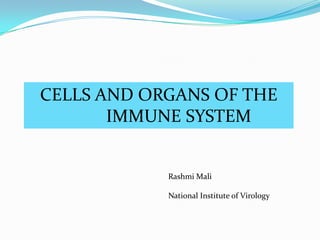
Cells and organs of the immune system
- 1. CELLS AND ORGANS OF THE IMMUNE SYSTEM Rashmi Mali National Institute of Virology
- 2. Components of the Immune System • Cells originate in the bone marrow. • Arise from pluripotent hematopoietic stem cells. (HSCs) • HSCs give rise to precursor cells which are myeloid progenitors and common lymphoid progenitors. • Myeloid progenitors give rise to granulocytes, macrophages, dendritic cells and mast cells. • Common lymphoid progenitors give rise to lymphocytes, dendritic cells and NK cells. • There are more myeloid progenitors in the bone marrow than lymphoid progenitors.
- 4. Granulocytes or Polymorphonuclear (PMN) Leukocytes A group of white blood cells is collectively referred to as granulocytes or polymorphonuclear leukocytes (PMNs). Granulocytes are composed of three cell types as Neutrophils Eosinophils Basophils These cells are important in the removal of bacteria and parasites from the body. They engulf these foreign bodies and degrade them using their powerful enzymes.
- 6. Neutrophils. Neutrophils constitutes 50-70% of the circulating WBC’s. Circulate for 7-10 h prior to migration to tissue; live 2-4 days in tissue. They are first cell to arrive to the infection site. It plays important role in inflammatory response. Phagocytic and bactericidal. Leukocytosis Extravasation Chemotactic factors
- 7. Eosinophils Eosinophils constitutes 1-3 % of the circulating WBC’s. Important in anti-parasite defenses. It presents Ag to T cell in body. Release of contents in eosinophilic granules can damage the parasite membrane. Eosinophils are associated with allergic diseases. The inappropriate release of their granule content can cause host cell damage leading to airway remodeling (fibrosis) in many cases.
- 8. BASOPHILS MAST CELLS
- 9. BASOPHIL Only present in the bloodstream, and represent <1% of circulating WBC. They are non-phagocytic cells. They play a major role in the allergic response. They release their granules (containing histamine, serotonin, heparin, prostaglandin, etc into the bloodstream following exposure to specific allergens). Basophils bear Fc receptors for IgE (FceRs) When an individual is exposed to an allergen, specific IgE is produced. This IgE binds to the surface of basophils. Upon re-exposure to the allergen, the allergen binds to IgE on the surface of basophils resulting in degranulation.
- 10. MAST CELLS Mast cells are released from the bone marrow as undifferentiated precursor cells and do not differentiate until they enter the tissues (skin, connective tissue, mucosal epithelium, etc.) Mast cells bear Fc receptors for IgE (FceRs) and contain cytoplasmic granules. Play a very important role in the development of allergic response. They produce a variety of cytokines. TNF is produced and stored within the cytoplasm of the mast cell, and it can be released quickly following mast cell activation.
- 11. NATURAL KILLER CELLS o NK cells constitutes 5-10% of lymphocytes in human peripheral blood . o They play important role in cell cytotoxicity. o They also play important role in innate immune response.
- 12. Monocytes vs M
- 13. Monocytes – Circulate in the blood. Macrophages –Circulate in the tissues. Macrophages are derived from the bone marrow and have a variety of functions in the immune response. Phagocytosis. Secretion of cytokines
- 14. DENDRITIC CELLS • Originate in the bone marrow • Function as antigen presenting cells (APC). • Four types of dendritic cells are – Langerhan’s cells Interstitial dendritic cells Myeloid cells Lymphoid dendritic cells
- 15. Organs Of Immune System Primary Lymphoid Organs Bone Marrow and Thymus Maturation Site Secondary Lymphoid Organs Spleen, lymph nodes, MALT (mucosal associated lymph tissue) GALT (gut associated lymph tissue) Trap antigen, APC, Lymphocyte Proliferation
- 16. Bone marrow. Located in the middle of your bones, most specifically your vertebrae, pelvic, and leg bones, it generates T cells, B cells, and macrophages — cells that travel throughout the body in the blood and tissue fluids.
- 17. THYMUS
- 18. THYMUS A bilobed organ located above heart near throat 15-20 g at birth grows up rapidly for first two years -40g at puberty – followed by involution – DiGeorge Syndrome congenital birth defect – lack of thymus – absence of T cell mediated immunity Each lobe – many lobules by fibrous septae – outer cortex and inner medulla Cortex – tightly packed – contains immature thymocytes Medulla – contains more mature cells
- 20. SPLEEN
- 21. PEYER’S PATCHES A Swiss anatomist, Johann Peyer, noticed that embedded in the villi-covered cells that line the small intestine are patches of smooth cells. Peyer's patches have high endothelial venules through which lymphocytes can enter, and they are outgoing lymphatics that drain lymph away from these tissues. There are no incoming lymphatics that bring lymph into Peyer's patches Smooth cell that crowns the Peyer's patch the one that doesn't have "hairs" (villi) on it is called an "M" cell. M cell is a specialized cell that transports antigen from the interior (lumen) of the intestine into the Peyer's patch.